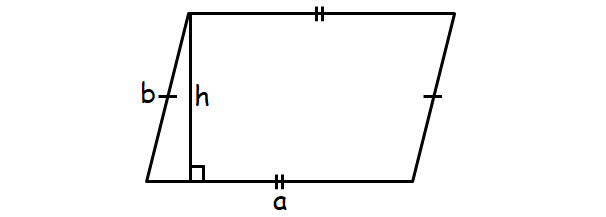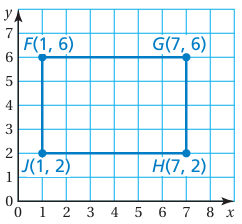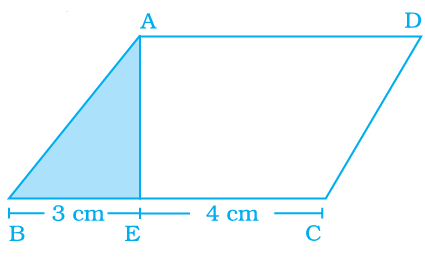PERIMETER OF PARALLELOGRAM
Subscribe to our ▶️ YouTube channel 🔴 for the latest videos, updates, and tips.
Perimeter is a path that surrounds a two dimensional shape. The term may be used either for the path or its length it can be thought of as the length of the outline of a shape.
Parallelogram is a quadrilateral in which opposite sides are parallel and equal as shown below.

Formula for perimeter of a parallelogram :
= 2a + 2b
= 2(a + b) units
Example 1 :
Find the perimeter of a parallelogram with the base and side length are 15 cm and 12 cm.
Solution :
Perimeter of a parallelogram :
= 2(a + b)
Substitute a = 15 and b = 12.
= 2(15 + 12)
= 2(27)
= 54 cm
Example 2 :
Find the perimeter of parallelogram with the base and side length are 9 ft and 3 ft.
Solution :
Perimeter of a parallelogram :
= 2(a + b)
Substitute a = 9 and b = 3.
= 2(9 + 3)
= 2(12)
= 24 cm
Example 3 :
If the perimeter of parallelogram is 40 in and its base is 15 in, find its side length.
Solution :
Perimeter of a parallelogram = 40
2(a + b) = 40
Substitute a = 15.
2(15 + b) = 40
30 + 2b = 40
Subtract 30 from each side.
2b = 10
Divide each side by 2.
b = 5
The side length of the parallelogram is 5 in.
Example 4 :
Prove that the points (5, 8), (6, 3), (3, 1) and (2, 6) form a parallelogram and also find the perimeter.
Solution :
Let A(5, 8), B(6, 3), C(3, 1) and D(2, 6).

Formula to find the distance between two points :
d = √[(x2 - x1)2 + (x2 - x1)2]
Length of AB :
Substitute (x1, y1) = A(5, 8) and (x2, y2) = B(6, 3) in the distance formula.
AB = √[(6 - 5)2 + (3 - 8)2]
= √[(1)2 + (-5)2]
= √[1 + 25]
= √26
Length of BC :
Substitute (x1, y1) = B(6, 3) and (x2, y2) = C(3, 1) in the distance formula.
BC = √[(3 - 6)2 + (1 - 3)2]
= √[(-3)2 + (-2)2]
= √[9 + 4]
= = √13
Length of DC :
Substitute (x1, y1) = D(2, 6) and (x2, y2) = C(3, 1) in the distance formula.
DC = √[(3 - 2)2 + (1 - 6)2]
= √[(1)2 + (-5)2]
= √[1 + 25]
= = √26
Length of AD :
Substitute (x1, y1) = A(5, 8) and (x2, y2) = D(2, 6) in the distance formula.
AD = √[(2 - 5)2 + (6 - 8)2]
= √[(-3)2 + (-2)2]
= √[9 + 4]
= = √13
length of AB = length of DC
length of AD = length of BC
Opposite sides are equal. So, the given points form a parallelogram.
Perimeter = 2(√26 + √13) units
Example 5 :
If the sides of a parallelogram are increased to twice its original lengths, how much will the perimeter of the new parallelogram?
(a) 1.5 times (b) 2 times (c) 3 times (d) 4 times
Solution :
Let a and b be the side lengths of parallelogram.
Perimeter of parallelogram = 2(a + b)
New dimension of parallelogram are 2a and 2b
Perimeter of new parallelogram = 2(2a + 2b)
= 2(2) (a + b)
= 2(perimeter of old parallelogram)
Perimeter of new parallelogram is two times the perimeter of old parallelogram.
Example 6 :
The vertices of a rectangle are F (1, 6), G (7, 6), H (7, 2), and J (1, 2). Draw the rectangle in a coordinate plane and find its perimeter.
Solution :

Length of rectangle = 7 - 1
= 6 units
Width of rectangle = 6 - 2
= 4 units
Perimeter of rectangle = 2(length + width)
= 2(6 + 4)
= 2(10)
= 20 units.
So, the perimeter of the rectangle is 20 units.
Example 7 :
What is the perimeter of the rectangle with the vertices shown below?
A (4, 7), B (4, 15), C (9, 15), D (9,7)
a) 8 units b) 13 units c) 26 units d) 70 units
Solution :
By drawing the rectangle with the given vertices, we get the length of rectangle as AB and width of rectangle as BC.
Length of rectangle = 15 - 7
= 8 units
Width of rectangle = 9 - 4
= 5 units
Perimeter of rectangle = 2 (length + width)
= 2(8 + 5)
= 2 (13)
= 26 units
So, the perimeter of the rectangle is 26 units.
Example 8 :
find the area and perimeter of parallelogram ABCD if the area of shaded triangle is 9 cm2.

Solution :
Area of triangle = (1/2) x base x height
Let h be the height of the triangle.
(1/2) x 3 x h = 9
h = 9(2/3)
= 6 cm
So, height of the triangle is 6 cm.
In the triangle ABE,
AB2 = AE2 + BE2
AB2 = 62 + 32
= 36 + 9
= 45
AB = √45
= √(3 x 3 x 5)
= 3√5
Perimeter of triangle = 2(3 + 4 + 3√5)
= 2(7 + 3√5)
= 14 + 6√5 cm
Area of parallelogram = base x height
= 7 x 6
= 42 cm2
Subscribe to our ▶️ YouTube channel 🔴 for the latest videos, updates, and tips.
Kindly mail your feedback to v4formath@gmail.com
We always appreciate your feedback.
About Us | Contact Us | Privacy Policy
©All rights reserved. onlinemath4all.com
Recent Articles
-
Quantitative Reasoning Questions and Answers
Dec 14, 25 06:42 AM
Quantitative Reasoning Questions and Answers -
Specifying Units of Measure
Dec 14, 25 06:38 AM
Specifying Units of Measure -
Coin Tossing Probability
Dec 13, 25 10:11 AM
Coin Tossing Probability - Concept - Sample Space - Formula - Solved Problems